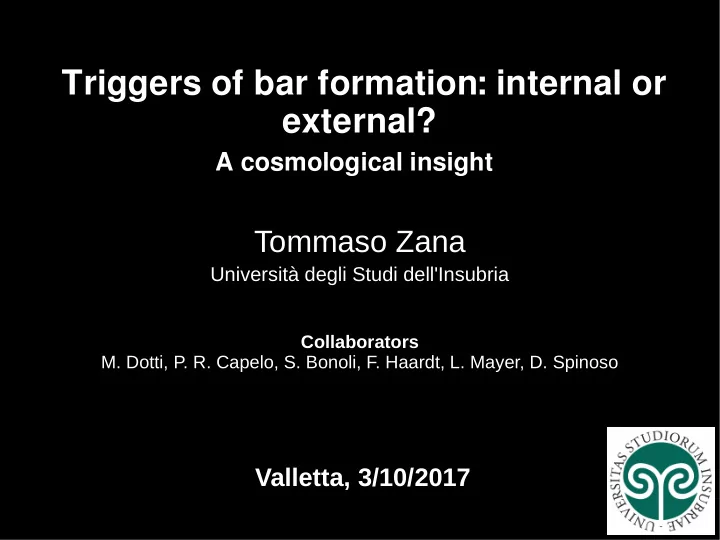

Triggers of bar formation: internal or external? A cosmological insight Tommaso Zana Università degli Studi dell'Insubria Collaborators M. Dotti, P. R. Capelo, S. Bonoli, F. Haardt, L. Mayer, D. Spinoso Valletta, 3/10/2017
Fraction of bars in massive disc galaxies ( ) ~60 % - NIR ~40 % - optical (Marinova & Jogee, 2007, Gavazzi et al., 2015 )
Bars play a key role in the evolution of disc galaxies
Bars play a key role in the evolution of disc galaxies NGC 6782 ● Triggering bursts of star formation where the gas becomes denser
Bars play a key role in the evolution of disc galaxies NGC 1073 ● Triggering bursts of star formation ● Quenching the star formation in the inner disc, once the bursts have depleted the gas
Bars play a key role in the evolution of disc galaxies NGC 1365 ● Triggering bursts of star formation ● Quenching the star formation ● Prompting AGN activity? if the gas is funneld toward the very inner part of the galaxy
Bars play a key role in the evolution of disc galaxies NGC 1353 ● Triggering bursts of star formation ● Quenching the star formation ● Prompting AGN activity? ● Building-up of a pseudo bulge dynamically different kind of galactic bulge
What causes a bar?
What causes a bar? ● Secular evolution
What causes a bar? ● Secular evolution ● Tidal Interaction
ErisBH simulation (Bonoli et al. 2016) High-resolution cosmological hydrodynamical simulation Milky Way-type galaxy from z = 90 up to z = 0 (Spinoso et al. 2016) At z = 0 the galaxy shows a strong bar of about 2 kpc in radius
The idea In ErisBH , the bar growth follows temporally a minor merger at z ~ 1.2
The idea In ErisBH , the bar growth follows temporally a minor merger at z ~ 1.2 different evolution of five slightly different initial condition sets: 1. ErisBH twin simulation (reduced) - WM 2. System deprived of the satellite responsible for the merger - NM
The idea In ErisBH , the bar growth follows temporally a minor merger at z ~ 1.2 different evolution of five slightly different initial condition sets: 1. ErisBH twin simulation (reduced) - WM 2. System deprived of the satellite responsible for the merger - NM 3. System also deprived of the major fly-by (z > 0.7) - NF
The idea In ErisBH , the bar growth follows temporally a minor merger at z ~ 1.2 different evolution of five slightly different initial condition sets: 1. ErisBH twin simulation (reduced) - WM 2. System deprived of the satellite responsible for the merger - NM 3. System also deprived of the major fly-by (z > 0.7) - NF 4. Fly-by satellite pushed away from the main galaxy - PF 5. Dark matter mass of the Fly-by satellite doubled - HF
The simulations ● gas, dark matter and star particles ● Spatial resolution ● Mass resolution ● Cooling and SN feedback
The simulations ● gas, dark matter and star particles ● Spatial resolution ● Mass resolution ● Cooling and SN feedback The code ChaNGa (Menon et al., 2015) ● treeSPH-code built on the SPH code Gasoline (Wadsley et al., 2004) and implemented with the Charm++ libraries
The simulations With the merger Without the merger Without the fly-by Stellar density Gas density 5 kpc
The simulations With the merger Without the merger Without the fly-by Stellar density Gas density 5 kpc
The simulations With the merger Without the merger Without the fly-by Stellar density Gas density 5 kpc
The simulations With the merger Without the merger Without the fly-by Stellar density Gas density 5 kpc
Fourier decomposition Z = 1.20 Z = 0.30 Z = 0
Fourier decomposition
Fourier decomposition
Fourier decomposition
Fourier decomposition
Fourier decomposition
X-shaped bulge emergence WM NM With Without the merger the merger NF HF Without Heavier the fly-by fly-by
Conclusions ● The origin of the bar forming in ErisBH run is not linked to any particular tidal event As long as the galactic potential is prone to bar instability, a bar develops independently of any interaction ● It seems that the fly-by could delay the growth of a bar Gravitational perturbers inhibit the bar formation process Zana et al. 2017 (In press)
Recommend
More recommend